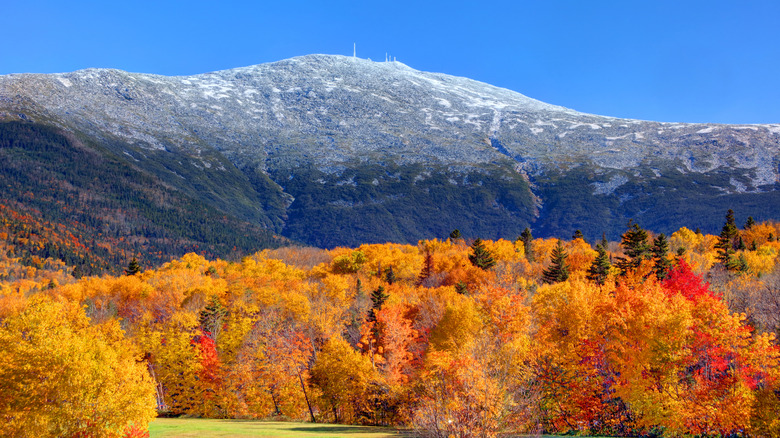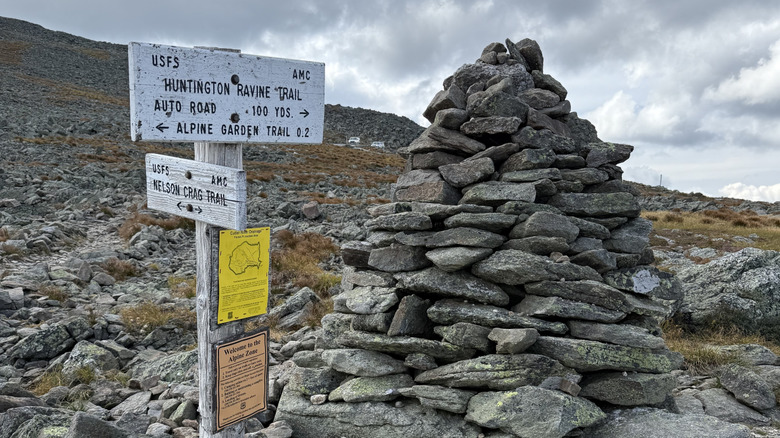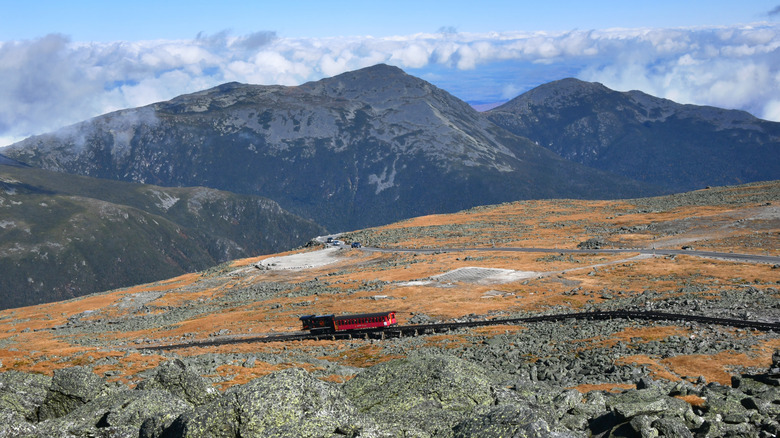Hidden In Mount Washington Is One Of America's Most Dangerous Hiking Trails With Record-Breaking Winds
With hundreds of miles of hiking trails and 800,000 acres of unspoiled wilderness, New Hampshire's White Mountains offer some of the best outdoor recreation in the Northeast. Home to lake towns like Gilford, the "recreation center of New Hampshire," and year-round outdoor hubs like the mountain village of North Conway, the Granite State is booming with great destinations for Type II fun.
In the heart of New Hampshire's White Mountain National Forest, the highest peak in the state (and in all the Northeast) reigns at 6,288 feet above sea level. The mighty Mount Washington towers over the surrounding summits of the Presidential Range, famous for their exposed ridgelines, record-breaking weather, and high-elevation hikes — including some of the most dangerous hiking trails in America. The Huntington Ravine Trail is the steepest hiking route in the White Mountains and one of the hardest to summit Mount Washington.
This challenging route isn't the only scary trail in the state. It has the bragging rights of being on the Terrifying 25 hiking list, a series of New Hampshire trails that are considered especially difficult and frightening. The Huntington Ravine Trail makes this list because of its rapid elevation gain, tough terrain, bouldering and rock scrambling, significant exposure to the elements, and some of the worst weather on Earth. In fact, Mount Washington's summit holds the record for the highest wind speed ever recorded by man — a jaw-dropping 231 mph in 1934 (via the Mount Washington Observatory).
Hiking New Hampshire's Huntington Ravine Trail to Mount Washington
New Hampshire's White Mountains are a high-altitude alpine paradise, and hiking to the summit of Mount Washington is a natural high unlike any other. To access Huntington Ravine, start on the Tuckerman Ravine Trail. The trailhead is located at Pinkham Notch, one of the visitors' centers managed by the Appalachian Mountain Club, who also operate rooms and bunkrooms for hikers onsite at Joe Dodge Lodge.
Once you hit the trail, you'll walk down a short stretch of old dirt road before the steeper climbing begins. At mile 1.3 on the Tuckerman Ravine Trail, you'll see the beginning of the Huntington Ravine Trail on the right. After the trail junction, make your way over typical New England hiking terrain — rugged, rocky, and rooty — before reaching the floor of Huntington Ravine. The trail is well-marked with trail markers or "blazes" painted on the rocks. Snow can be present here until after Memorial Day, so it's a good idea to bring an ice ax if you're hiking outside the summer months. From here, the trail really starts to climb, and the stunning views will propel you forward.
The Huntington Ravine Trail joins the Alpine Garden at around 5,600 feet, where the trail becomes slightly less steep. At this point, you can summit Mount Washington by traversing the boulder field and following the Huntington Ravine Trail until it meets the Nelson Crag Trail; or you can follow the Auto Road the rest of the way. Enjoy the summit views, snacks, and history exhibits at the top. When you've had your fill of summit glory, be sure to head back down the mountain on a different trail. It is not recommended to descend via the Huntington Ravine Trail — it should be considered a one-way hiking route, up, and only in dry conditions.
How to summit Mount Washington without having to climb
There are several ways to reach the top of Mount Washington, often referred to as "America's Everest." This popular summit sees close to 400,000 visitors every year, and not all of them get there by hiking. The Mount Washington Cog Railway, the first mountain-climbing cog in the world, has been climbing to the summit of New Hampshire's highest peak via rail since 1869. In less than an hour, passengers are transported through three climate zones with panoramic views of the White Mountains before reaching the summit station.
You can also reach the summit by driving the world-famous Mount Washington Auto Road, first opened in 1861 and the first man-made tourist attraction in America. The road gains over 4,000 feet across 7.6 miles and offers unbelievable views without getting out of your car. On top of the scenery, the summit is equipped with gift shops, a cafeteria, the Tip Top House Museum (formerly a hotel), and the Sherman Adams Visitor Center with a rooftop observation deck.
In the winter months, the Auto Road to Mount Washington's summit is closed to vehicles, but there is still a unique way to reach the summit. Bundle up and board the snowcat or snowcoach, a track-propelled vehicle designed to navigate deep snow and icy terrain. The tours offer a thrilling journey through snow-capped trees and snow-covered peaks, all while staying warm inside a vehicle. These snow tours make the experience of Mount Washington accessible to non-hikers seeking the majesty of these mighty mountain views and the legendary extreme weather of its summit. Plan accordingly, and be prepared, as even New Hampshire's most dangerous hikes will repay you with unforgettable memories of adventure.


